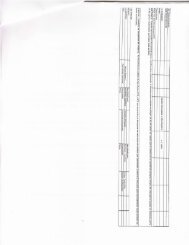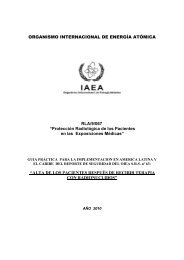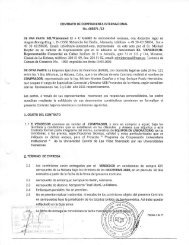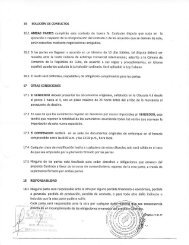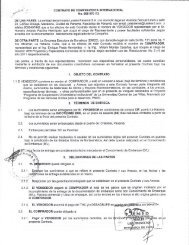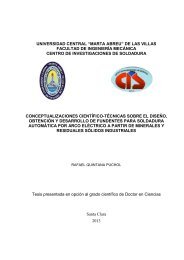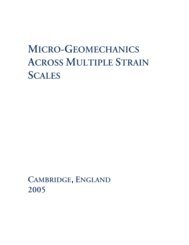You also want an ePaper? Increase the reach of your titles
YUMPU automatically turns print PDFs into web optimized ePapers that Google loves.
416<br />
The hybrid FEM/BEM was first proposed <strong>in</strong> [238],<br />
then followed <strong>in</strong> [239,240] as a general stress analysis<br />
technique. In <strong>rock</strong> <strong>mechanics</strong>, it has been used ma<strong>in</strong>ly<br />
for simulat<strong>in</strong>g the mechanical behaviour of underground<br />
excavations, as reported <strong>in</strong> [241–245]. The<br />
coupl<strong>in</strong>g algorithms are also presented <strong>in</strong> detail <strong>in</strong> [48].<br />
The hybrid DEM/BEM model was implemented<br />
only for the explicit dist<strong>in</strong>ct element method, <strong>in</strong> the<br />
code group of UDEC and 3DEC. The technique<br />
was created <strong>in</strong> [246–248] for stress/deformation analysis.<br />
In [249–250] a development of hybrid discrete-cont<strong>in</strong>uum<br />
models was reported for coupled hydro-mechanical<br />
analysis of fractured <strong>rock</strong>s, us<strong>in</strong>g comb<strong>in</strong>ations<br />
of DEM, DFN and BEM approaches. In [251], a<br />
hybrid DEM/FEM model was described, <strong>in</strong> which<br />
the DEM region consists of rigid blocks and the<br />
FEM region can have non-l<strong>in</strong>ear material behaviour.<br />
A hybrid beam-BEM model was reported <strong>in</strong> [252]<br />
to simulate the support behaviour of underground<br />
open<strong>in</strong>gs, us<strong>in</strong>g the same pr<strong>in</strong>ciple as the hybrid BEM/<br />
FEM model. In [253], a hybrid BEM-characteristics<br />
method is described for non-l<strong>in</strong>ear analysis of <strong>rock</strong><br />
caverns.<br />
The hybrid models have many advantages, but special<br />
attention needs to be paid to the cont<strong>in</strong>uity or<br />
compatibility conditions at the <strong>in</strong>terfaces between<br />
regions of different models, particularly when different<br />
material assumptions are <strong>in</strong>volved, such as rigid and<br />
deformable block–region <strong>in</strong>terfaces.<br />
2.7. Neural networks<br />
L. J<strong>in</strong>g, J.A. Hudson / International Journal of Rock Mechanics & M<strong>in</strong><strong>in</strong>g Sciences 39 (2002) 409–427<br />
All the numerical modell<strong>in</strong>g <strong>methods</strong> described so far<br />
are <strong>in</strong> the category of ‘1:1 mapp<strong>in</strong>g’, i.e., the Level 1<br />
<strong>methods</strong> <strong>in</strong> Fig. 1. The neural network approach is a<br />
‘non-1:1 mapp<strong>in</strong>g’ <strong>in</strong> the Methods C and D categories of<br />
the Level 2 <strong>methods</strong> <strong>in</strong>dicated <strong>in</strong> Fig. 1. The <strong>rock</strong> mass is<br />
represented <strong>in</strong>directly by a system of connected nodes,<br />
but there is not necessarily any physical <strong>in</strong>terpretation of<br />
the geometrical or mechanistic location of the network’s<br />
<strong>in</strong>ternal nodes, nor of their <strong>in</strong>put and output values.<br />
Such a ‘non-1:1 mapp<strong>in</strong>g’ system has its advantages and<br />
disadvantages.<br />
The advantages of neural networks are that<br />
(1) The geometrical and physical constra<strong>in</strong>ts of the<br />
problem, which dom<strong>in</strong>ate the govern<strong>in</strong>g equations<br />
and constitutive laws when the 1:1 mapp<strong>in</strong>g<br />
techniques are used, are not such a problem.<br />
(2) Different k<strong>in</strong>ds of neural networks can be applied<br />
to a problem.<br />
(3) There is the possibility that the ‘perception’ we<br />
enjoy with the human bra<strong>in</strong> may be mimicked <strong>in</strong> the<br />
neural network, so that the programs can <strong>in</strong>corporate<br />
judgements based on empirical <strong>methods</strong> and<br />
experiences.<br />
The disadvantages are that<br />
(1) The procedure may be regarded as simply supercomplicated<br />
curve fitt<strong>in</strong>g—because the program has<br />
to be ‘taught’.<br />
(2) The model cannot reliably estimate outside its range<br />
of tra<strong>in</strong><strong>in</strong>g parameters.<br />
(3) Critical mechanisms might be omitted <strong>in</strong> the model<br />
tra<strong>in</strong><strong>in</strong>g.<br />
(4) There is a lack of any theoretical basis for<br />
verification and validation of the techniques and<br />
their outcomes.<br />
Neural network models provide descriptive and<br />
predictive capabilities and, for this reason, have been<br />
applied through the range of <strong>rock</strong> parameter identification<br />
and eng<strong>in</strong>eer<strong>in</strong>g activities. Recent published works<br />
on the application of neural networks to <strong>rock</strong> <strong>mechanics</strong><br />
and <strong>rock</strong> eng<strong>in</strong>eer<strong>in</strong>g <strong>in</strong>cludes the follow<strong>in</strong>g publications.<br />
* Stress–stra<strong>in</strong> curves for <strong>in</strong>tact <strong>rock</strong> [254].<br />
* Intact <strong>rock</strong> strength [255,256].<br />
* Fracture aperture [257].<br />
* Shear behaviour of fractures [258].<br />
* Rock fracture analysis [259].<br />
* Rock mass properties [260,261].<br />
* Microfractur<strong>in</strong>g process <strong>in</strong> <strong>rock</strong> [262].<br />
* Rock mass classification [263,264].<br />
* Displacements of <strong>rock</strong> slopes [265].<br />
* Tunnel bor<strong>in</strong>g mach<strong>in</strong>e performance [266].<br />
* Displacements and failure <strong>in</strong> tunnels [267,268].<br />
* Tunnel support [269,270].<br />
* Surface settlement due to tunnell<strong>in</strong>g [271].<br />
* Earthquake <strong>in</strong>formation analysis [272].<br />
* Rock eng<strong>in</strong>eer<strong>in</strong>g systems (RES) modell<strong>in</strong>g [273,274].<br />
* Rock eng<strong>in</strong>eer<strong>in</strong>g [275].<br />
* Overview of the subject [276].<br />
As evidenced by the list of highlighted references<br />
above, the neural network modell<strong>in</strong>g approach has been<br />
widely applied and is considered to have significant<br />
potential—because of its ‘non-1:1 mapp<strong>in</strong>g’ character<br />
and because it may be possible <strong>in</strong> the future for such<br />
networks to <strong>in</strong>clude creative ability, perception and<br />
judgement, and be l<strong>in</strong>ked to the Internet. However, the<br />
method has not yet provided an alternative to conventional<br />
modell<strong>in</strong>g, and it may be some time before it can<br />
be used <strong>in</strong> the comprehensive Box 2D mode envisaged <strong>in</strong><br />
Fig. 1 and described <strong>in</strong> [277].<br />
3. Coupled thermo-hydro-mechanical (THM) models<br />
The coupl<strong>in</strong>gs between the processes of heat transfer<br />
(T), fluid flow (H) and stress/deformation (M) <strong>in</strong><br />
fractured <strong>rock</strong>s have become an <strong>in</strong>creas<strong>in</strong>gly important<br />
subject s<strong>in</strong>ce the early 1980s [278,279], ma<strong>in</strong>ly due to the



